|

by Gildas Bourdais
Posted: 23:59 January 19, 2008
from
UFODigest Website
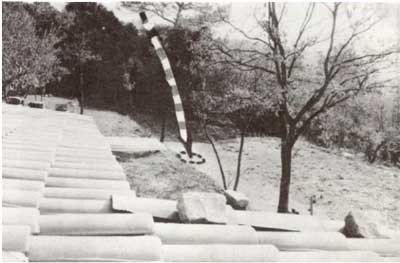
France drew international attention in
March 2007 when GEIPAN, the official service in charge of
investigating UFOs, announced that it was beginning to put all its
UFO files on its web site - 1,650 cases in all, containing some
6,000 testimonies - gathered in more than thirty years of inquiries,
since its creation in 1977 (actually, some earlier cases are on file
as well).
The release of these files is what French UFOlogists had been
demanding for years, some of them suspecting the authorities of
hiding UFO files from the public. Actually, the files now being made
public appear to be more of the "sleeping kind" than of the secret
kind. GEIPAN has finally made this decision in order to put an end
to these speculations. It is not certain however, that it will end
the question of possible secret files, which would be held outside
GEIPAN, with a military "secret" stamp (as we will see).
GEIPAN is a small part of the prestigious Centre National
d'Etudes Spatiales (CNES) with its website at
http://www.cnes.fr/web/5038-geipan.php
There was an incredible worldwide demand to access the files
(unanticipated by CNES, whose servers weren't up to the challenge),
and it was difficult, during a few days, to access the UFO files. A
similarly huge number of visitors deluged the Chicago Tribune
website after the paper published a story on the UFO that was seen
over O'Hare Airport, November 7, 2006. Interest in UFOs remains
pervasive, even when discounted and discouraged by the
establishment.
GEIPAN (Groupe d'Etudes et d'Information sur les
Phénomènes Aérospatiaux Non identifiés, or Group for Study and
Information on Unidentified Aerospatial Phenomena") is the current
name of the French UFO project. Its mother agency, CNES,
headquartered in Paris, but with a research facility in Toulouse, is
the French equivalent of NASA. It is in charge of the base of Kourou
in French Guyana, used for the launching of rockets and satellites,
together with the European organization ESA.
GEIPAN has almost the same name as the initial GEPAN, created in
1977, but with an "I" added for "Information." Indeed, information
is the primary goal of GEIPAN, with the task of releasing all the
files on the CNES/GEIPAN web site.
In order to better understand the
present situation, let's first briefly review the history of
official French UFO studies.
French
UFOlogy - Born… Killed… and Reborn
The first organization for the study of UFOs in France, GEPAN, was
created in 1977 by the Director of CNES, Yves Sillard, who named an
engineer, Claude Poher, as its head.
It was supervised by a "Scientific Council," which had to report its
activity at least once a year. Poher had already done personal work
on the subject, after reading the Condon report and meeting with the
American astronomer, J. Allen Hynek. Previously, a decision
had also been made, in 1974, to gather reports about UFOs
systematically from the gendarmerie (military police), and transmit
a copy of them to CNES.
At that time, the gendarmerie had collected more than 300 reports
and was collecting about 100 new reports each year. That same year,
a committee of the Institut des Hautes Etudes de Défense
Nationale (IHEDN) had made recommendations for the
creation of such an organization. I should note here that, from the
beginning, there was a special interest in the military in the study
of UFOs, in contrast with the seeming lack of interest, if not open
hostility, on the part many people in the scientific and
intellectual establishment. This explains why, after a couple of
years at GEPAN, Claude Poher resigned.
He said later that he was disappointed
by the apparent lack of interest of the Scientific Council, in spite
of the support of Yves Sillard.
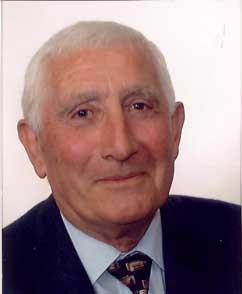
Yves Sillard,
Former Director of CNES,
President of the steering committee of GEIPAN
From 1979 to 1983, however, GEPAN was
quite active, led by a young engineer, Alain Esterle, and the
staff expanded to 10 at one time (for the early history of GEPAN,
see Gildas Bourdais, "From GEPAN to SEPRA: Official UFO Studies in
France", IUR 25:4, Winter 2000-2001).
The project had the good luck to come
across several very interesting cases. Most prominent among these
were those of Trans-en-Provence in 1981, and of "L'Amarante" in
1982.
GEPAN published its findings on these cases in Technical notes,
numbers 16 and 17. They drew a lot of attention, even abroad, but,
apparently, the scientific establishment did not welcome them
because, shortly afterwards, the activity of GEPAN was drastically
reduced. Esterle left and his assistant, Jean-Jacques Velasco, took
over the operation of GEPAN. Velasco managed to keep the activity
alive, but with very reduced means.
In 1988, the name GEPAN was even dropped and the project was renamed
SEPRA, a curious name meaning Service d'Etude des
Phénomènes de Rentrées Atmosphériques (Department for the Study
of Atmospheric Re-entry Phenomena), which did not refer directly to
UFOs any more. The Scientific Council was essentially closed, and no
more technical notes were published.
After a period of great confusion about the fate of French UFO
studies, the service was eventually reactivated at CNES, in July
2005. Here is how it happened.
Toward the end of the 1990s, the SEPRA had a very limited activity,
and some people would probably have liked to kill it for good. But
others claimed that it should be reactivated and granted more
resources for a new beginning. This was the opinion of
the Cometa Report in 1999, written
by an independent group comprised of senior officers, both military
and civilian.
I would like at this point to correct a mistake, seen in the Sunday
Times article of March 25, "Spooky... They Start a UFO Website, Then
it Crashes." It mentions the Cometa Report (without naming it) as a
French government publication, released by the IHEDN (Institut
des Hautes Etudes de Défense Nationale). This is incorrect. The
report was written by a private group, the Cometa (even if it
is true that it had been encouraged at the beginning by the head of
IHEDN, General Bernard Norlain). But it has probably been
influential in the reactivation of French UFO studies.
At CNES, the new director Gérard Brachet decided in 2001 to
audit the UFO project. It was conducted by an outsider, François
Louange, an expert in photo analysis who had participated in UFO
studies at CNES. In 2002, Louange gave (like the Cometa but
quite independently) a favorable report that recommended the
reactivation and the new development of SEPRA.
This was echoed in the French press,
notably in an important article published in the major newspaper, Le
Figaro, in November 2002:
"OVNIS -L'état doit y consacrer
plus de moyens"
(UFOs. The state
must give more resources for their study)
Surprisingly, in January 2004, CNES then
decided to close SEPRA.
What had happened?
Most likely, some influential people were opposed to the
reactivation of SERPA. But it is a fact that the man in charge of
SEPRA, engineer Jean-Jacques Velasco, after some twenty years
at the "UFO desk," had made up his mind to come out and give his
personal opinion about UFOs. Mr. Velasco was just completing a book,
published in April 2004, under the rather provocative title OVNIS:
L'évidence ("UFOs: The Evidence").
There is a play on words in this title because the primary meaning
of "evidence" in French is "obviousness". Velasco meant that the
reality of UFOs is obvious, and he worsened his case by adding that
their ET origin is very probable, as well, just like the Cometa
Report did in 1999. Presumably, his book also weighed heavily in the
decision to close SEPRA.
The conservative magazine Ciel et Espace
announced in June 2004:
"CNES buries UFOs"
This was a deliberately shocking title.
But it was not the end of the story!
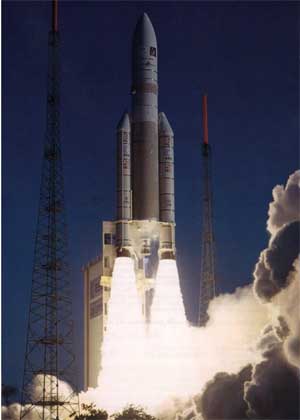
The Launch of
France's Ariane 5 Rocket
Kourou, French Guyana
The Rebirth of "SEPRA"
as "GEIPAN"
A new article of Le Figaro, of July 31, 2004, revealed that CNES was
now embarrassed by its decision and was already planning the rebirth
of SEPRA, under a new name and with a new man at the helm. Finally,
the decision was made in July 2005 by a new Director of CNES,
Yannick d'Escatha, to create a department for the study of UFOs
once again. Another engineer was named to replace Jacques Velasco.
He was Jacques Patenet, 59, a man
with a long career at CNES in rocket launching, including the Ariane
rockets, at the launching site at Kourou in French Guiana.
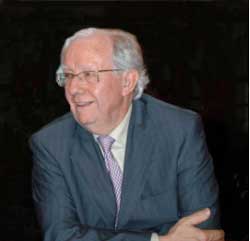
Jacques Patenet
French Engineer who replaced SERPA's Jacques Vellasco
as the new Director of GEIPAN
Like the old GEPAN, Patenet and the
GEIPAN are under the authority of the CNES hierarchy, but they are
also under the control of a "steering committee," called "COPEIPAN
("Comité de pilotage" of GEIPAN). This committee is headed by Yves
Sillard - the man who created GEPAN in 1977, now retired after a
brilliant career at the head of CNES and at other important posts.
At their first meeting in September 2005, the committee proposed to
give the name GEIPAN to the reborn French UFO service.
As listed on the GEIPAN web site, the
steering committee, COPEIPAN, consists of 15 permanent members:
-
Representatives of such civilian
and military authorities as the gendarmerie, police, civil
security, DGAC (Direction Générale de l'Aviation Civile),
and the French Air Force
-
Representatives of the
scientific world: CNRS (Centre national de la Recherche
Scientifique), the weather bureau
-
CNES, itself.
As with the old GEPAN, agreements of
cooperation have been created or updated with these different
institutions.
GEIPAN may also rely on a network
of specialists, so that it is again fully able to work efficiently
on new cases.
The Release of
UFO Files
In January 2006, Jacques Patenet announced that GEIPAN was
going to put all its UFO files on the CNES web site. The project is
under way, with the release of some 480 files at the end of June
2007, covering the period 1988-2005.
This caused quite a stir in the mass
media, and even Ciel et Espace was obliged to correct its
previous stance about CNES's burial of UFOs with a new article in
May 2006, entitled:
"OVNIS: Le CNES ouvre ses
dossiers"
("UFOs: CNES opens its files").
Beware: There are UFOs, after all!
The release of the UFO files was
announced in many newspapers, with a much more positive tone. The
well-known weekly magazine, L'Express, devoted six pages to
the subject, something that had not happened for several decades in
France. On the other hand, some trendy publications like the weekly
Le Nouvel Observateur and the daily, Libération, did
not print one word about it. So, there is still, obviously, a long
way to go in this country, which still sees itself as a champion of
rationalism.
The release of the UFO files was announced in many newspapers, with
a much more positive tone. The well-known weekly magazine,
L'Express, devoted six pages to the subject, something that had
not happened for several decades in France. On the other hand, some
trendy publications like the weekly Le Nouvel Observateur and
the daily, Libération, did not print one word about it.
So, there is still, obviously, a long
way to go in this country, which still sees itself as a champion of
rationalism.
OVNIS Appear
Once Again in L'Express
March 22, 2007
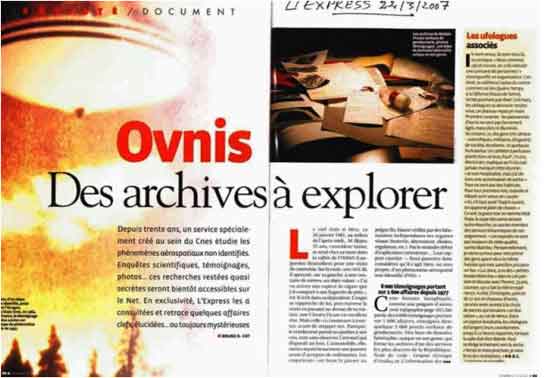
Recently, Jacques Patenet
appeared, with Alain Cirou, the editor of Ciel et Espace,
on a well-known TV program called ''C dans l'air" ("It's in
the air"), televised on March 30.
Questioned bluntly by host and journalist, Yves Calvi, on the
reality of UFOs, Patenet said unequivocally that,
"Yes, there are UFOs, even if there
are not many" (in his opinion).
Calvi then asked the same question to
Cirou who, obviously embarrassed, made a more evasive answer. I was
invited, too, and I can say that it was a very amusing moment. It
signaled, perhaps, the beginning of a new tone in the French media
in regard to UFOs.
Until recently, the same journalist would have rather invited,
together with Cirou, the astronomer, André Brahic, well known
for his total skepticism on UFOs. On the other hand, a sociologist,
Pierre Lagrange, a friend of Cirou, was also there, but he gave
signs of changing subtly his standard opinion on UFOs, away from his
usual psychosocial explanation to a prudent recognition of a certain
reality of UFOs.
However, the battle is not over in the French media. On June 29, a
new TV show at the national network, France 3, "Pièces à
conviction", leaned heavily in favor of the skeptics, such as
Henri Broch, of the group, "Zététique", which is the French
version of the American CSICOP. On the other hand, the daily paper
Libération, granted me a one page, positive interview, on August 3.
But let's forget about that and come back to the UFO files.
The first inquiries made by CNES began in 1977 with the creation of
the first service called "GEPAN," but there are files from the 1950s
& 1960s (and even one dating from 1937!).
As we have seen, the gendarmerie already had more than 300 files in
1974, and it was then collecting about one hundred reports a year.
In 1978, the first statistical study, made by Claude Poher,
was based upon 678 reports. There are now 1,650 "official" files in
France, including some 6,000 witnesses, comprising more than 100,000
pages of documents. The rest of GEIPAN's UFO files should be posted
by the end of this year (although that seems a rather ambitious
goal).
In any case, a first effect of this
project seems to have been a renewed estimate of the percentage of
unknown cases, rather dramatically, as we shall now see.
Unknown
Cases…Now at 28 %
In March 2007, Jacques Patenet gave a number of interviews,
in which he warned that we are not going to find any new important
(but previously unknown) cases. The best, such as Trans-en-Provence
in 1981 (allegedly, the brief landing of a small UFO, with traces
left on the ground), are known already. However, there is some new
information worth mentioning:
The number of unidentified cases after serious study (the "PAN D"
category) is now estimated at 25 to 28 % (depending on the day of
the interview, apparently). On the web site of GEIPAN, the
percentage is, indeed, 28%.
Here is the repartition in the four key
categories used by the project:
-
PAN A (perfectly identified
phenomena): 9 %
-
PAN B (probably identified): 33
% (A + B = 42%)
-
PAN C (insufficient data): 30 %
-
PAN D (unidentified): 28 %
Please note that it would not be
appropriate to add PAN C and D, which would make for 58% of
unknowns, as some have claimed recently in Canada (The National
Post, for example). The percentage of unidentified is more than has
been previously published. In recent years, the percentage of
unknown phenomena was still given at around 13 % or 14 %.
Actually, in the book just published,
Phénomènes spatiaux non identifiés, Yves Sillard gives
the following percentages:
For his part, Jean-Jacques Velasco,
in his book, which was reissued recently under the title Troubles
dans le ciel (Troubles in the Sky") still gives the previous
figures, very close to those of Yves Sillard:
-
PAN A + B: 46. %
-
PAN C: 40.6%
-
PAN D: 13.5%
So, how do we explain this?
It appears that GEIPAN has (very recently) re-evaluated the
percentage of unknowns. Interestingly, this new percentage of
unknowns (28 %) is more in line with the very first results of GEPAN,
which had been established by Claude Poher, based on the
analysis of 678 reports.
Actually, the unknowns were much higher:
Jean-Jacques Velasco also compares, in
his book, the percentages of French UFOs with those found in the
fifties in the USA by the Batelle Memorial Institute for
Project Blue Book. These findings
were kept confidential at the time, but published later in the
famous Special Report 14.
Their findings, based on the statistical study of 1,959 usable
reports from the period 1952-1954, were, using the equivalent
categories:
-
PAN A + B: 49, 6 %
-
PAN C: 18. 9 %
-
PAN D: 21. 5 %
However, the most publicized percentage
of unknowns, established globally in 1969 on the complete files of
the Blue Book commission of 12,618 cases was 5.5 %. But we
know that the U.S. Air Force had made every effort to reduce that
number (and the percentage has increased since then as others,
including Alan J. Hynek, re-evaluated the case files).
So, the percentage of unknowns apparently remains, even today, a
rather uncertain and debatable statistic. But it seems to be much
higher than the classic, oft-cited 5 %.
Some
Differences of Opinions
Yves Sillard, the President of the Steering Committee
(COPEIPAN), had already expressed his views on UFOs in
several interviews as of September 2005. Sillard did it once again
in an important collective book on UFOs, released in France at the
beginning of April 2007.
Its title is:
Phénomènes spatiaux non
identifiés
Un défi à la science
(Unidentified Aerospatial Phenomena. A Challenge to
Science).
Publisher by Le Cherche Midi.
See the web site
www.cherche-midi.com
It is not an exaggeration to say that
the opinions of Yves Sillard are a bit more affirmative than those
of the engineer, Jacques Patenet, in his own interviews on the
official presentation of GEIPAN on its web site and in his chapter
of Sillard's book.
One idea put forward by Jacques Patenet is that the extraterrestrial
hypothesis is conceivable, but that there is "not the slightest
solid proof for it, or against it, as well".
This is a very restrictive stance. The extraterrestrial hypothesis
is very evident in the book, expressed not only by Sillard but by
other contributors, notably the astrophysicist, Jean-Claude Ribes,
CNES engineer Pierre Marx, author François Parmentier,
and police chief Dominique Weinstein, even if they don't all
say so as clearly.
Ribes and Marx discuss possible future means of exploration of
interstellar space (which may have been already mastered somewhere
else in the universe), and Weinstein provides much old data on
aeronautical cases worldwide that confirm the physical presence of
UFO in our skies, including detection by radar and electromagnetic
effect cases.
For his part, Sillard offers briefly in his introduction four
primary hypotheses for the explanation of UFOs:
-
Psychological
-
Secret military air/space
craft
-
Rare physical phenomena
-
The Extraterrestrial
Hypothesis (ETH)
Furthermore, Sillard published these
words about the ETH (page 19):
"(ETH) being the only hypothesis
which, at the present stage, brings an eventual perspective to
explain the phenomena, the existence of which is indisputable,
an attitude of frightened rejection without examination does not
seem to be the good approach, however".
There is thus clearly some variance of
opinion on UFOs, even among people in charge of or associated with
the new GEIPAN. Their collective efforts, a book written under the
editorial direction of Yves Sillard, has the merit of showing these
different opinions and attitudes honestly, and it is another notable
event on the French UFO scene, coming on the heels of the release of
French UFO files.
Again, the opinions expressed in that
book range from mere skepticism about the extraterrestrial origin of
UFOs, as in the stance of the Dominican theologian, Jacques
Arnould, who is a counselor on ethics at CNES, to an analysis of
the tough problem of UFO secrecy, mainly observed in the United
States, by contributor François Parmentier.
Parmentier had already written a whole book on that difficult
subject, published in 2004, entitled:
OVNI. 60 ans de désinformation
("UFOs: 60 Years of Disinformation")
Sillard is obviously open to such a
viewpoint, as we could already see in his interviews of September
2005, in which he criticized the American policy of denial of UFOs.
However, he refrains from expressing it so bluntly in the book,
which aims at a consensus. That is not an easy task, to say the
least.
Jacques Patenet, for his part, is careful to keep a good
distance between him and what could be considered radical opinions.
Still, in his conclusion, Sillard denounces "the climate of
suspicion and disinformation, even derision, that dismisses witness
testimony and stems from surprising intellectual blindness."
These are strong words and a new tone, indeed, on the part of the
President of the GEIPAN "steering committee." They remind us of the
conclusions of the Cometa Report, which has been posted, by the way,
on the GEIPAN website.
We also note that Yves Sillard pays
tribute to engineer, Jean-Jacques Velasco, who managed to maintain
the UFO activity alive, in spite of few resources and "very reduced
moral support".
UFO Cases -
Explained and Unexplained
On its web site, GEIPAN provides some examples of both
explained and unexplained cases.
As an example of the former, in 1985 near the city of Royan on the
Atlantic coast, a metallic fragment was found that was at first
presumed to be piece of the Russian satellite COSMOS 1629. But on
closer examination, it was officially identified as a German
propulsive device dating from the Second World War. Here now, on the
contrary, are some cases still considered unexplained by GEIPAN.
Trans-en-Provence - 8 January 1981
This is probably the most famous French UFO case, which has been in
described in the GEPAN Technical Note No 16. Technical No 16 relates
the account of a retired worker who, while in his garden, saw a
small round craft land briefly and depart, leaving a round trace on
the ground. The inquiry also revealed unexplained effects on the
surrounding plants, possibly caused by an electromagnetic field.
However, some French skeptics have dismissed the case as being the
trace of tire track left by a truck!
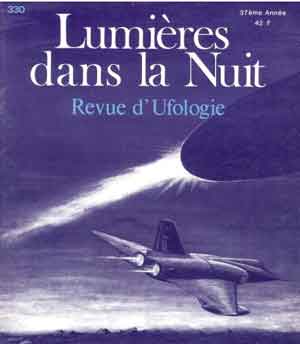
Another major case, which has been cited
by Jacques Patenet on the TV program "C dans l'air," above
mentioned, is a very close confrontation with a UFO in the air by a
military pilot, Colonel Giraud, aboard a Mirage IV nuclear bomber in
1977. It was already presented, prominently, in the Cometa report in
1999.
There are many more cases, which are now beginning to be published.
Let's mention at least two other well-known cases in France.
L'Amarante - Nancy, 1982
L'Amarante in Nancy, in 1982, which was published by GEPAN, recounts
the case of very close observation of a small UFO, hovering silently
for about twenty minutes above ground, and which left unexplained
effects on surrounding plants called "amarantes."
Valensole 1965
On the morning of July 1, 1965, Maurice Masse was going to start
working on his field, at about 5:45 a.m. when he heard a whistling
noise. Then he saw a machine in his field, shaped like a rugby
football, standing on six legs with a central pivot stuck into the
ground, with two small beings next to it (see FSR, "A Visit at
Valensole" for more details).
Masse approached, crossing a vineyard, which was next to his field,
and when he was close (about 5 meters), one of the beings pointed a
pencil-like instrument at him, which paralyzed him. The two beings
entered the craft. The craft whirled and the landing legs retracted.
With a thump of the central pivot, the
machine took off to float silently away, in the direction of the
town of Manosque.

Two kinds of traces were reported at
Valensole:
-
The main, circular trace at the
touchdown site of the landing, which remained for a long
time
-
A long trace, which was made
visible by the effects it left in a swath on lavender
plants, along the path the craft took when it departed
Are There
Still Secret UFO Files in France?
A frequently asked question, among French UFOlogists, is whether or
not there are still secret files in France. When CNES announced the
release of its UFO files, many people claimed with excitement that
France was opening its "secret files"!
This was wrong and had to be corrected immediately. As I noted,
these files were more likely to be covered by dust than by a layer
of secrecy. According to Yves Sillard, in Phénomènes
aérospatiaux non identifiés, there was at least a legal problem
to solve, as those files don't really belong to CNES but, for the
most part, to the Gendarmerie nationale (which continues to collect
witness testimony). And there are also some files from the French
Air Force.
That being said, a nagging question remains, in France as in other
countries, about the existence of secret UFO files and studies. In
Great Britain, for instance, Nick Pope, who staffed the UFO
desk from 1991 to 1994 at the Ministry of Defense, still argues that
he has not heard of any secret UFO files in his country. On the
other hand, he freely admits that, in the famous case of an alleged
UFO landing in Rendlesham Forest in December 1980, there was
undoubtedly a cover-up policy on the part of the U.S. Air Force,
which was occupying the nearby air base at the time.
So it seems obvious that the case of the
United States deserves special examination.
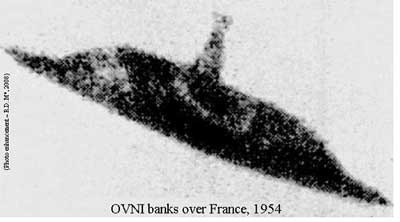
"Trouble in the
Sky"
Photo enhancement of famous Rouen OVNI photo of 1954 (true origin
unknown)
reveals fine details of structure and hull form, similar to those
shown in the
famous Trent photos taken in McMinnville, Oregon, USA in 1950
"Reconnoitre" these cases at -
http://homepage.ntlworld.com/mjpowell/Rouen/Rouen.htm
It's plausible that the French military
retain some secret UFO files that have remained outside CNES.
According to Patenet, the French Air Force had already opened, in
1954, a service of documentation called SEMOC (Section
d'étude des mystérieux objects célestes) and, presumably, there
are some classified files there that have not been released to CNES.
Nevertheless, it seems that there is nothing in France comparable to
the many rumours and testimony about government and military
secrets, including the Roswell case in the United States.
Let's give an example of a famous case, during the big wave of 1954,
the alleged landing at Quarouble, which remains somewhat clouded in
military secrecy.
Quarouble 1954
Quarouble, 1954, perhaps the most famous case of the French 1954
wave, remains classified. This was the site of a close encounter of
the third kind in Quarouble, near the Belgian border.
On the night of September 10, at 10.30 p.m., Marius Dewilde,
a steel worker, was confronted with two little beings, just in front
of his little home, situated in a rather isolated area, next to a
railway track. They paralyzed him, and then climbed aboard a craft
which had landed on the railway track, and which took off rapidly.
Dewilde was terrified and ran to the
nearest police station. There was a very serious inquiry involving
three official agencies: the police, the "gendarmerie de l'Air", and
the DST (Direction de la Surveillance du Territoire),
but nothing was published of it.
However, two years later, the journalist Aimé Michel learned, from a
railway engineer who had participated in the investigation, that
imprints found on the wooden rail sleepers had revealed that the
craft weighted about 30 tons! Jean-Jacques Velasco says, in his book
Troubles dans le ciel ("Trouble in the Sky") that he tried
for several years to obtain for SEPRA the files of that inquiry, but
to no avail.
Velasco could find no official record of that important case…
Where is that
file, now?
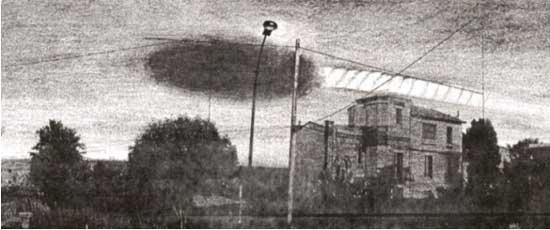
A Russian Rocket
Re-entry Over France?
November 5, 1990
An example of confusion, according to
the GEIPAN file, was the re-entry of a Russian rocket stage, which
crossed France on November 5, 1990. Well, there were obviously lots
of observations of that rocket debris burning in the high
atmosphere. But not everyone, including me, agrees that it could
explain all the numerous observations. It seems that many
observations, covering a large part of the French territory, don't
fit well with the re-entry phenomenon.
As a resident in the nearby west suburb
of Paris, I came across a couple of testimonies about a big black
shape coming over the area on a trajectory, which could hardly be
confused with the Russian rocket re-entry, owing to the angles of
observation.
Could it be that a part of what happened that evening has been kept
secret?
That's the opinion of many UFOlogists, including my friend, Joël
Mesnard, director of the review, Lumières dans la Nuit,
even though he does admits that there was, indeed, a rocket re-entry
at the same time.
Putting France Back
on the UFO Track
It is still too early to tell what will come out of this new
organization but, for the time being, it has already had the
positive effect of renewing interest for UFOs in France, resulting
in a number of articles, discussions on TV and radio, and even
drawing the attention of the press and public worldwide.
In conclusion, we can say that there are, indeed, many strong UFO
cases, which are recognized, officially, or almost officially, and
that the reality of UFOs is admitted officially alive in France
today, in spite of still negative attitudes in some circles.
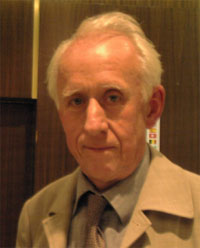
Gildas Bourdais
Paris, France
|










